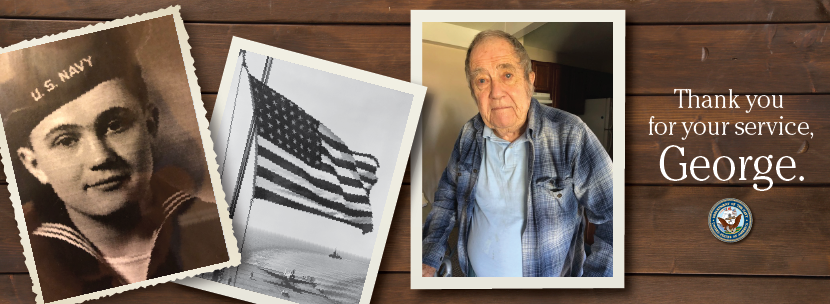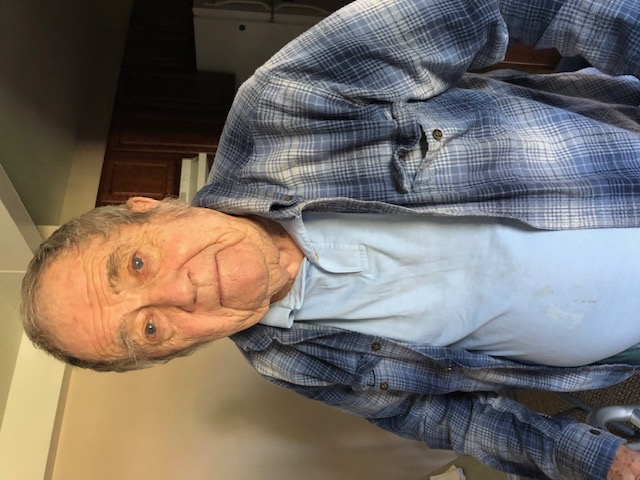 December 18th, 2025
December 18th, 2025

One WWII Veteran’s Journey: George's Story
 George who calls American House Sterling Meadows home is 94 years young. Although today’s not his birthday, it is a birthday he holds dear to his heart, the Navy’s. And, we’re here to tell his story.
George who calls American House Sterling Meadows home is 94 years young. Although today’s not his birthday, it is a birthday he holds dear to his heart, the Navy’s. And, we’re here to tell his story.
It’s 1926, the year Henry Ford established the 40-hour work week, “Winnie-the-Pooh” was published, the first fuel rocket was launched and George Weber was born.
Although born in Detroit, George attended school at Assumption College in Windsor, Ontario and upon graduation in 1943. He would then head home to Detroit to enlist in the Navy before being drafted.
“I chose the Navy so I didn’t end up in the infantry,” George explained.
He attended basic training in Great Lakes, Illinois and then an electricians course, for which he was chosen based on his aptitude testing for job placement.
“I was given the choice to either work in the Medical Corps or as an Electrician’s Mate,” George noted.
He chose the latter and found himself aboard a troop train to San Francisco by 1944.
In San Francisco, he was assigned to the USS Santee. The Santee was an old Sinclair oil tanker, which had been converted out of wartime necessity into an escort aircraft carrier.
These “jeep” carriers as they were sometimes known, carried a smaller component of aircraft and were employed in large numbers as an alternative to the much more expensive fleet carriers that could take a year or more to build. The USS Santee had just been repaired from damage sustained in the Battle of Leyte Gulf near the Philippines.
George joined the ship’s crew as an Electrician’s Mate and the Santee sailed west to make a stop at Pearl Harbor.
Near Pearl Harbor, the Santee ran aground and George and his shipmates were “forced” to spend three weeks in Honolulu while repairs to the ship’s propeller were made. Once repaired, they continued west to the Marshall Islands to meet up with the other ships that would make up their task force, and then on to Guam where they were to pick up their combat aircraft for future operations.
“Our aircraft component featured Grumman F6F Hellcat fighters, and TBF Avenger torpedo bombers, which totaled about 28 aircrafts,” he stated.
George’s duties on ship as an Electrician’s Mate included changing lightbulbs, among other duties. He was able to get familiar with the ship and as the task force sailed north into Japanese waters, he even found himself on mess duty – which he says he enjoyed thoroughly.
In April of 1945, George’s task force found itself supporting the invasion of the Japanese held island of Okinawa. It was to be the largest amphibious operation since D-Day and the USS Santee did its part to support the marines’ amphibious assault on the island.
Aircraft from the USS Santee flew sorties repeatedly above the contested island in support of the marines ashore.
“At this time, I was responsible for bringing lemonade and snacks to the Santee’s sailors who were at battle stations for long periods of time,” George explained.
Despite the Navy’s heavy losses during this campaign in 1945, the USS Santee was fortunate to avoid damage to herself or her crew.
The battle for Okinawa was officially over by June 22, 1945 and George and his Santee shipmates sailed north again to the Japanese coastline. There they flew combat sorties over mainland Japan in preparation for the Allies final invasion of their home islands. Following the dropping of Atomic bombs over Hiroshima and Nagasaki, the Santee’s aircraft were tasked with taking pictures of those cities from above to survey the damage.
Following the Japanese surrender, George and the USS Santee took on new roles.
Now they sailed to the island of Formosa (now Taiwan) where they were to recover prisoners taken by the Japanese earlier in the war.
For George this meant he and his shipmates would be taking aboard a large number of British prisoners, now released as part of the surrender.
“These men were so frail they often had to be brought aboard the ship in baskets, as they had spent nearly five years as prisoners of war in Japanese camps,” George said.
These grateful men had full roam of the ship and he saw them frequently in the ship’s galley (dining hall) happily eating and regaining their strength.
They stopped briefly in Manilla before going back to Japan for occupation duty for a few weeks.
Next, they were to sail back to Long Beach, California before undertaking a new mission – the Santee would now have all aircraft personnel and equipment removed and the ship was refitted with additional sleeping quarters.
They sailed back to Japan and loaded fully with American servicemen who were returning home to be discharged.
“We called these Magic Carpet Voyages because duties were much lighter with the war officially over,” George explained.
They then sailed through the Panama Canal and up the eastern seaboard to Boston, where the USS Santee was to be officially mothballed by the US Navy. George received his discharge, hitched a ride with a buddy back to Toledo and took a bus back home to Detroit.
After the war, George went to college at the University of Detroit and while pursuing his bachelor’s degree in electrical engineering, he met his future wife, Margaret. Now a married man he took his first job working on the massive early analog computers with Detroit Edison at their building on 2nd Ave.
He left Edison to work as an electrician with the Detroit Fire Department and worked exclusively on the city’s early fire alarm boxes used throughout the city for the next six years. When the city began moving to other fire warning methods, George left to work for Chrysler, who employed him to work on their new USAF defense contracts making ballistic missiles.
After a while, Chrysler relocated George, Margaret and their six children to New Orleans where he worked on SATURN 1 rockets. These were the origin of the rockets that would eventually take the Apollo spacecraft to the moon in 1969.
Now Chrysler’s defense contracts were absorbed by General Dynamics and he found himself in their employment and transferred back to Detroit to work on the M60A2 battle tank, but not before having two more children (Katie and Larry) during their time in New Orleans. They would have a total of eight children together.
He would stay with General Dynamics until his retirement in 1988.
Today George enjoys life at American House, where he enjoys gardening, building amazing Lego sets and completing various puzzles.
We all have a story. A story that defined us. Changed us. Taught us something. Our seniors have a wealth of stories that store a wealth of wisdom.
At American House, your next chapter is waiting to be written. We’re here to help you write it. Your way.
Written by: Todd Schuver, Executive Director of American House Sterling Meadows
More to read
Let’s find your community
Maintaining a home and your health can become a challenge as you age. American House provides the care, amenities and services that make life easier. Find out how American House can help you live life to its fullest.


